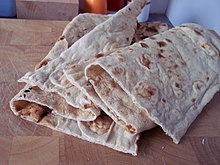Podpłomyk: Difference between revisions
H0lyh0lywiki (talk | contribs) No edit summary |
H0lyh0lywiki (talk | contribs) No edit summary |
||
| Line 15: | Line 15: | ||
| other = |
| other = |
||
}} |
}} |
||
{{Unreferenced|date=December 2009}} |
|||
'''Podpłomyk''' ({{lang-pl|plural: podpłomyki}}; German: fladen; {{lang-ukr|перепічка}}, perepichka, підпалок, pidpalok) is a simple kind of [[flat bread]], often made without [[yeast]]. |
'''Podpłomyk''' ({{lang-pl|plural: podpłomyki}}; German: fladen; {{lang-ukr|перепічка}}, perepichka, підпалок, pidpalok) is a simple kind of [[flat bread]], often made without [[yeast]]. |
||
Podpłomyk was a common kind of food in ancient [[Slavic peoples|Slavic societies]], where it was made on stones heated up in a fire. Podpłomyki were also made in newer times by those who could not afford an enclosed [[stove]]. Before the mid-19th century, many poor Polish [[peasant]] homes had only open fireplaces, and the "thick" bread required careful heating in an [[oven]]; to overcome the problem, such ovens were sometimes communally-owned. Now podpłomyk, actually having never fully disappeared, has become popular again due to the interest in (pre-) medieval everyday life. Made of [[flour]], [[water]] and [[salt]], podpłomyki are often eaten with [[honey]] or "konfitury" (a kind of [[jam]]). Sometimes a podpłomyk was made to test the temperature of the baker's oven before the first batch of bread was made. |
Podpłomyk was a common kind of food in ancient [[Slavic peoples|Slavic societies]], where it was made on stones heated up in a fire. Podpłomyki were also made in newer times by those who could not afford an enclosed [[stove]].<ref>{{cite web |title=Podplomyki - Polish Flat Bread Recipe |url=https://polishfoodies.com/podplomyki-polish-flat-bread-recipe/ |website=Polish Foodies |date=27 April 2022}}</ref> Before the mid-19th century, many poor Polish [[peasant]] homes had only open fireplaces, and the "thick" bread required careful heating in an [[oven]]; to overcome the problem, such ovens were sometimes communally-owned. Now podpłomyk, actually having never fully disappeared, has become popular again due to the interest in (pre-) medieval everyday life. Made of [[flour]], [[water]] and [[salt]], podpłomyki are often eaten with [[honey]] or "konfitury" (a kind of [[jam]]).<ref>{{cite journal |last1=Anderson |first1=Claire M. |title=In Search of the Origins of the Opłatek |journal=The Polish Review |date=1 October 2013 |volume=58 |issue=3 |pages=65–76 |doi=https://doi.org/10.5406/polishreview.58.3.0065}}</ref> Sometimes a podpłomyk was made to test the temperature of the baker's oven before the first batch of bread was made. |
||
{{Flatbreads}} |
{{Flatbreads}} |
||
Revision as of 14:00, 7 November 2022
 Prepared flatbread | |
| Type | Flatbread |
|---|---|
| Place of origin | Poland |
| Main ingredients | Flour, water, salt |
Podpłomyk (Polish: plural: podpłomyki; German: fladen; Ukrainian: перепічка, perepichka, підпалок, pidpalok) is a simple kind of flat bread, often made without yeast.
Podpłomyk was a common kind of food in ancient Slavic societies, where it was made on stones heated up in a fire. Podpłomyki were also made in newer times by those who could not afford an enclosed stove.[1] Before the mid-19th century, many poor Polish peasant homes had only open fireplaces, and the "thick" bread required careful heating in an oven; to overcome the problem, such ovens were sometimes communally-owned. Now podpłomyk, actually having never fully disappeared, has become popular again due to the interest in (pre-) medieval everyday life. Made of flour, water and salt, podpłomyki are often eaten with honey or "konfitury" (a kind of jam).[2] Sometimes a podpłomyk was made to test the temperature of the baker's oven before the first batch of bread was made.
- ^ "Podplomyki - Polish Flat Bread Recipe". Polish Foodies. 27 April 2022.
- ^ Anderson, Claire M. (1 October 2013). "In Search of the Origins of the Opłatek". The Polish Review. 58 (3): 65–76. doi:https://doi.org/10.5406/polishreview.58.3.0065.
{{cite journal}}: Check|doi=value (help); External link in|doi=

